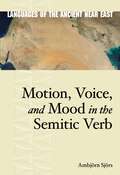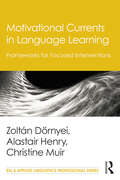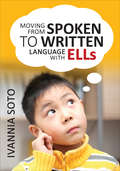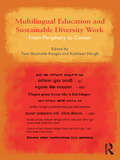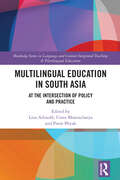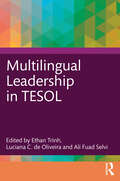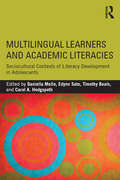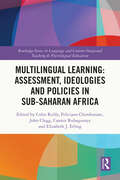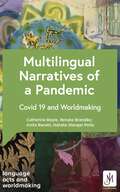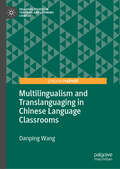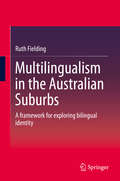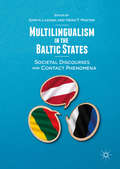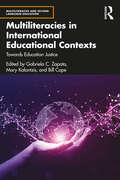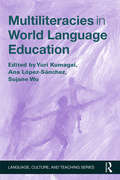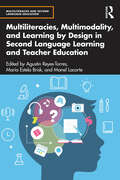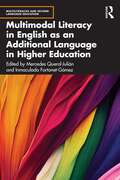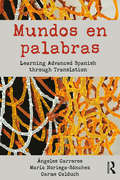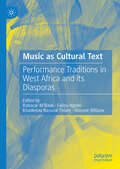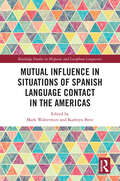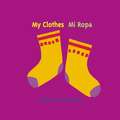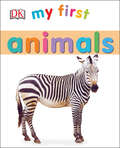- Table View
- List View
Motion, Voice, and Mood in the Semitic Verb (Languages of the Ancient Near East)
by Henning Ambjörn SjörsThis book explores the relationship between the so-called ventive morpheme in Akkadian (-am) and the related suffixes -n and -a in other Semitic languages, including Amarna Canaanite, Ugaritic, Hebrew, and Arabic. Using formal reconstructions of the various morphemes and a functional analysis of their different usages, Ambjörn Sjörs convincingly argues that these endings are cognate morphemes that were formally and functionally related to the ventive morpheme in Akkadian.Sjörs provides a systematic description of non-allative ventive verbs in Old Babylonian, the energic and volitive in Amarna Canaanite, the energic and lengthened prefix conjugation in Ugaritic, the lengthened imperfect consecutive in Biblical Hebrew, and the subjunctive and energic in Classical Arabic. Sjörs explains how these verb forms were used within the framework of grammaticalization theory and demonstrates how the suffixes are historically related.Clearly and persuasively argued, Motion, Voice, and Mood in the Semitic Verb sheds valuable light on the Akkadian ventive and its relationship to the other related morphemes. It will be welcomed by linguists specializing in Akkadian, Amarna Canaanite, Ugaritic, Hebrew, and Arabic.
Motivational Currents in Language Learning: Frameworks for Focused Interventions (ESL & Applied Linguistics Professional Series)
by Zoltán Dörnyei Alastair Henry Christine MuirBuilding on Zoltán Dörnyei’s authoritative work in the field of learner motivation, this book introduces a new conceptualization—Directed Motivational Currents (DMCs)—and sets out the defining aspects of what they are, what they are not, and how they are related to language learning motivation. Going beyond focused behavior in a single activity, DMCs concern intensive long-term motivation. The distinctive feature of the theory is that it views motivation not simply as a springboard for action but also as a uniquely self-renewing and sustainable process. It is this energizing capacity which distinguishes DMCs from almost every other motivational construct described in the research literature. Motivational Currents in Language Learning offers new insights, valuable both to motivation researchers and classroom practitioners. The accessible style, along with plentiful illustrations and practical suggestions for promoting sustained learning, invite readers to think about motivation in a different way. Highly relevant for language teachers, teachers-in-training, teacher educators, and researchers in TESOL and applied linguistics, the book explains how the DMC construct can be integrated into course structures and teaching methodologies, and encourages teachers to try out novel methods for harnessing motivational power in classroom settings.
Moving From Spoken to Written Language With ELLs
by Ivannia SotoMastering spoken language is the key to writing success for English language learners English language learners struggle to meet the increased classroom writing demands of the Common Core State Standards, and many schools seem at a loss for solutions. In these pages, ELL expert Ivannia Soto builds on the groundbreaking research she presented in her previous book ELL Shadowing as a Catalyst for Change to show how oral language development scaffolds writing skills. To implement this knowledge, Soto offers educators a powerful set of tools: • Exciting spoken techniques such as Socratic Seminar, Frayer model and Think-Pair-Share that build vocabulary and extend into academic writing • Approaches to teaching three essential styles of writing: argumentative, procedural, and narrative • Sample lesson plans and graphic organizer templates ELLs must develop oral language skills before meeting the Common Core’s writing requirements. This book provides the tools to make this happen. "This timely book collects oral language strategies designed to scaffold academic writing for English language learners at intermediate and advanced levels of English proficiency. Concrete examples support the goal of teaching college and career ready standards across content areas." —Charlene Rivera, Research Professor The George Washington University Center for Equity and Excellence in Education
Moving From Spoken to Written Language With ELLs
by Ivannia SotoMastering spoken language is the key to writing success for English language learners English language learners struggle to meet the increased classroom writing demands of the Common Core State Standards, and many schools seem at a loss for solutions. In these pages, ELL expert Ivannia Soto builds on the groundbreaking research she presented in her previous book ELL Shadowing as a Catalyst for Change to show how oral language development scaffolds writing skills. To implement this knowledge, Soto offers educators a powerful set of tools: • Exciting spoken techniques such as Socratic Seminar, Frayer model and Think-Pair-Share that build vocabulary and extend into academic writing • Approaches to teaching three essential styles of writing: argumentative, procedural, and narrative • Sample lesson plans and graphic organizer templates ELLs must develop oral language skills before meeting the Common Core’s writing requirements. This book provides the tools to make this happen. "This timely book collects oral language strategies designed to scaffold academic writing for English language learners at intermediate and advanced levels of English proficiency. Concrete examples support the goal of teaching college and career ready standards across content areas." —Charlene Rivera, Research Professor The George Washington University Center for Equity and Excellence in Education
Multilingual Education and Sustainable Diversity Work: From Periphery to Center
by Tove Skutnabb-Kangas Kathleen HeughThis very original, inspirational book globalises our understanding of languages in education and changes our understanding of bilingual and multilingual education from something mostly western to being truly transnational: it spotlights the small, celebrates African and Asian cases of multilingual classrooms and demonstrates that such education is universally successful. Colin R. Baker, Pro Vice-Chancellor, Bangor University, Bangor, Wales, UK A norm-setting work on multilingual education, which combines theoretical perspectives with practical experience from different parts of the globe, this book demonstrates convincingly not only that multilingual education works, but also that, for most developing countries, there is no viable alternative. Ayo Bamgbose, Professor Emeritus, University of Ibadan, Nigeria This excellent volume brings to light the fascinating lived experiences of multilingual education in linguistically rich but resource impoverished countries, and offers important lessons from which we can all learn. Amy B. M. Tsui, Professor , Pro Vice-Chancellor & Vice President, The University of Hong Kong, Hong Kong This is a book of hope and inspiration. Documenting the significant shift that is taking place in countries around the world in the status and legitimacy of mother tongue-based multilingual education, it represents a giant step towards a "tipping point" where mother tongue-based multilingual education will be normalized as the preferred and, in fact, common sense option for educating the children of the world. Jim Cummins, The University of Toronto, Canada This important book challenges us to think about multilingual education from a different angle––this time putting the periphery at the center. The effect is one of destabilizing old visions and imagining new worlds where multilingual education provides the backdrop for generous understandings of all peoples. Ofelia García, Program in Urban Education, Graduate Center/The City University of New York, USA There are regrettably few detailed accounts of successful elementary school instruction in the pupils' home language, which makes this book with its surprising examples (especially Ethiopia and Nepal but other third world cases) so relevant. Students of language education policy will learn a great deal about the possibility of multilingual education from the chapters of this important book. Bernard Spolsky, Professor Emeritus, Bar-Ilan University, Israel At least half of today’s languages are marginalised and endangered and the attention of the world needs to be focused on these minor and minority languages together with the value of multilingualism. If the book succeeds in enhancing the consciousness of the world towards predicaments of the third world, then its efforts will have been amply rewarded. Debi Prasanna Pattanayak, Former Director, Central Institute of Indian Languages, India Drawing on the most powerful and compelling research data to date and connecting this research to linguistic human rights, this book explores the conditions and practices of robust bilingual and multilingual educational innovations in both system-wide and minority-settings and what it is that makes these viable. It demonstrates how, in countries where educational practices are inclusive of linguistic diversity and responsive to local conditions and community participation, implementation of bilingual education even within limited budgetary investment can be successful.
Multilingual Education in South Asia: At the Intersection of Policy and Practice (Routledge Series in Language and Content Integrated Teaching & Plurilingual Education)
by Prem Phyak Lina Adinolfi Usree BhattacharyaSpanning scholarly contributions from India, Nepal, Bangladesh, Pakistan, and Sri Lanka, this edited volume seeks to capture and elucidate the distinct challenges, approaches and possible solutions associated with interpreting, adapting and applying language-in-education policies in a range of linguistically complex teaching and learning environments across South Asia. Centring on-the-ground perspectives of scholars, practitioners, pupils, parents and the larger community, the volume offers new insights into one of the most complex, populous, and diverse multilingual educational contexts in the world. Language-in-education policies and practices within this setting represent particularly high stakes issues, playing a pivotal role in determining access to literacy, thereby forming a critical pivot in the reproduction of educational inequality. The broad aim of the collection is thus to highlight the pedagogical, practical, ideological and identity-related implications arising from current language-in-education policies in this region, with the aim of illustrating how systemic inequality is intertwined with such policies and their associated interpretations. Aimed at both academics and practitioners - whether researchers and students in the fields of education, linguistics, sociology, anthropology or South Asian studies, on the one hand, or language policy advisors, curriculum developers, teacher educators, teachers, and members of funding bodies, aid providers or NGOs, on the other - it is anticipated that the accounts in this volume will offer their readership opportunities to consider their wider implications and applications across other rich multilingual settings – be these local, regional, national or global.
Multilingual Leadership in TESOL
by Luciana C. de Oliveira Ali Fuad Selvi Ethan TrinhMultilingual Leadership in TESOL addresses issues related to leadership by and for multilingual individuals in the field. Chapters in this edited volume provide a strong theoretical grounding for multilingual leadership, use case studies and autoethnographies to showcase multilingual leaders’ backgrounds, and discuss challenges and opportunities for current and future leaders in TESOL. Presenting a wide view of leadership development in the field, this book includes contributions from top scholars from over a dozen countries, ethnicities and language backgrounds.Bringing together the dual focus on multilingualism and leadership, this is essential reading for scholars, researchers and future leaders in TESOL and applied linguistics.
Multilingual Learners and Academic Literacies: Sociocultural Contexts of Literacy Development in Adolescents
by Daniella Molle Edynn Sato Timothy Boals Carol A. HedgspethShifting the discourse from a focus on academic language to the more dynamic but less researched construct of academic literacies, this volume addresses three key questions: • What constitutes academic literacy? • What does academic literacy development in adolescent multilingual students look like and how can this development be assessed? • What classroom contexts foster the development of academic literacies in multilingual adolescents? The contributing authors provide divergent definitions of academic literacies and use dissimilar theoretical and methodological approaches to study literacy development. Nevertheless, all chapters reflect a shared conceptual framework for examining academic literacies as situated, overlapping, meaning-making practices. This framework foregrounds students’ participation in valued disciplinary literacy practices. Emphasized in the new college and career readiness standards, the notion of disciplinary practices allows the contributing authors to bridge the language/content dichotomy, and take a more holistic as well as nuanced view of the demands that multilingual students face in general education classrooms. The volume also explores the implications of the emphasis on academic literacy practices for classroom instruction, research, and policy.
Multilingual Learning: Assessment, Ideologies and Policies in Sub-Saharan Africa (Routledge Series in Language and Content Integrated Teaching & Plurilingual Education)
by Elizabeth J. Erling Feliciano Chimbutane John Clegg Colin Reilly Casmir RubagumyaThis edited volume provides the follow up to Erling et al.’s (2021) Multilingual Learning and Language Supportive Pedagogies in Sub-Saharan Africa. The strategies put forward in Volume 1 included multilingual pedagogies that allow students to draw on their full linguistic repertoires, translanguaging and other language supportive pedagogies. While there is great traction in the pedagogical strategies proposed in Volume 1, limited progress has been made in terms of multilingual education in SSA. Thus, the main focus of this follow-up volume is to explore the question of why former colonial languages and monolingual approaches continue to be used as the dominant languages of education, even when we have multilingual pedagogies and materials that could and do work and despite substantial evidence that learners have difficulties when taught in a language they do not understand. This book offers perspectives to answer this question through focusing on the internal and external pressures which impact the capacity for implementing multilingual strategies in educational contexts at regional, national, and community levels. Chapters provide insights into how to better understand and work within these contemporary constraints and challenge dominant monoglossic discourses which inhibit the implementation of multilingual education in SSA. The volume focuses on three main areas which have proven to be stumbling blocks to the effective implementation of multilingual education to date, namely: Assessment, Ideology and Policy. An insightful collection that will be of great interest to academics, researchers, and practitioners in the fields of language education, language-in-education policy and educational assessments in the wide range of multilingual contexts in Africa.
Multilingual Narratives of a Pandemic: Covid 19 and Worldmaking (Language Acts and Worldmaking)
by Various Professor Catherine BoyleWe narrate everything. We construct the world around us by telling its stories, shaping the language we use to describe what is happening to us; language that is used and adapted in the media in response to moments of crisis. This language in turn shapes how we see the world. This is what we call 'worldmaking'. When we look for solutions to problems, we so often start by telling stories to each other in our communities, stories that set a crisis in context, relate it to our historical experience, help us to understand it in the context of our local communities and contrast those stories to dominant narratives. In this way, language becomes a physical and material force in our world, through which we construct our personal, local, transnational and spiritual identities.'Worldmaking in the Time of COVID-19', the project that informs this book, was an early response to the experience of living through the COVID-19 pandemic - intended as a contribution to our collective understanding of the COVID-19 pandemic. Following comparison and analysis of over 1.1 million news articles from 117 countries in twelve different languages, this timely reflection follows the course of this investigation, with three main objectives: - to capture the languages of the early pandemic (January-April 2020); - to offer a transferable methodology for exploring world events in multiple languages; - and to share some of the key findings of researchers. Like all the volumes in the Language Acts and Worldmaking series, the overall aim is two-fold: to challenge widely-held views about language learning as a neutral instrument of globalisation and to innovate and transform language research, teaching and learning, together with Modern Languages as an academic discipline, by foregrounding its unique form of cognition and critical engagement. Specific aims are to:· propose new ways of bridging the gaps between those who teach and research languages and those who learn and use them in everyday contexts from the professional to the personal· put research into the hands of wider audiences· share a philosophy, policy and practice of language teaching and learning which turns research into action· provide the research, experience and data to enable informed debates on current issues and attitudes in language learning, teaching and research· share knowledge across and within all levels and experiences of language learning and teaching· showcase exciting new work that derives from different types of community activity and is of practical relevance to its audiences· disseminate new research in languages that engages with diverse communities of language practitioners.
Multilingual Narratives of a Pandemic: Covid 19 and Worldmaking (Language Acts and Worldmaking)
by Various Professor Catherine BoyleWe narrate everything. We construct the world around us by telling its stories, shaping the language we use to describe what is happening to us; language that is used and adapted in the media in response to moments of crisis. This language in turn shapes how we see the world. This is what we call 'worldmaking'. When we look for solutions to problems, we so often start by telling stories to each other in our communities, stories that set a crisis in context, relate it to our historical experience, help us to understand it in the context of our local communities and contrast those stories to dominant narratives. In this way, language becomes a physical and material force in our world, through which we construct our personal, local, transnational and spiritual identities.'Worldmaking in the Time of COVID-19', the project that informs this book, was an early response to the experience of living through the COVID-19 pandemic - intended as a contribution to our collective understanding of the COVID-19 pandemic. Following comparison and analysis of over 1.1 million news articles from 117 countries in twelve different languages, this timely reflection follows the course of this investigation, with three main objectives: - to capture the languages of the early pandemic (January-April 2020); - to offer a transferable methodology for exploring world events in multiple languages; - and to share some of the key findings of researchers. Like all the volumes in the Language Acts and Worldmaking series, the overall aim is two-fold: to challenge widely-held views about language learning as a neutral instrument of globalisation and to innovate and transform language research, teaching and learning, together with Modern Languages as an academic discipline, by foregrounding its unique form of cognition and critical engagement. Specific aims are to:· propose new ways of bridging the gaps between those who teach and research languages and those who learn and use them in everyday contexts from the professional to the personal· put research into the hands of wider audiences· share a philosophy, policy and practice of language teaching and learning which turns research into action· provide the research, experience and data to enable informed debates on current issues and attitudes in language learning, teaching and research· share knowledge across and within all levels and experiences of language learning and teaching· showcase exciting new work that derives from different types of community activity and is of practical relevance to its audiences· disseminate new research in languages that engages with diverse communities of language practitioners.
Multilingualism and Translanguaging in Chinese Language Classrooms (Palgrave Studies in Teaching and Learning Chinese)
by Danping WangThis book presents new research on Chinese as a Second Language (CSL) teaching from an ethnographic classroom study on classroom translanguaging practices that highlights the policy and pedagogical implications of adopting a creative and principled multilingual approach. Drawing on a case study from Hong Kong, it analyses naturally observed language patterns in CSL classrooms and the attitudes of students and teachers towards prescribed classroom language policies, and thereby demonstrates the importance of mixing Chinese, English and students’ home languages to achieve successful second language learning. It discusses the nature and guiding principles for classroom translanguaging research and provides research tools that will enable second language teachers to examine their own language practices. The author argues persuasively that second language teaching practices and policies must reflect the current reality of language use and the diverse learning needs of multilingual students. This book will appeal to teacher educators and researchers in fields such as second language acquisition, foreign language teaching and language policy.
Multilingualism in the Australian Suburbs
by Ruth FieldingThis book introduces a framework for examining bilingual identity and presents the cases of seven individual children from a study of young students' bilingual identities in an Australian primary school. The new Bilingual Identity Negotiation Framework brings together three elements that influence bilingual identity development - sociocultural connection, investment and interaction. The cases comprise individual stories about seven young, bilingual students and are complemented by some more general investigations of bilingual identity from a whole class of students at the school. The framework is explained and supported using the students' stories and offers readers a new concept for examining and thinking about bilingual identity. This book builds upon past and current theories of identity and bilingualism and expands on these to identify three interlinking elements within bilingual identity. The book highlights the need for greater dialogue between different sectors of research and education relating to languages and bilingualism. It adds to the increasing call for collaborative work from the different fields interested in language learning and teaching such as TESOL, bilingualism, and language education. Through the development of the framework and the students' stories in this study, this book shows how multilingual children in one school in Australia developed their identities in association with their home and school languages. This provides readers with a model for examining bilingual identity in their own contexts, or a theoretical construct to consider in their thinking on bilingualism, language and identity.
Multilingualism in the Baltic States: Societal Discourses And Contact Phenomena
by Heiko F. Marten Sanita LazdiņaThis edited collection provides an overview of linguistic diversity, societal discourses and interaction between majorities and minorities in the Baltic States. It presents a wide range of methods and research paradigms including folk linguistics, discourse analysis, narrative analyses, code alternation, ethnographic observations, language learning motivation, languages in education and language acquisition. Grouped thematically, its chapters examine regional varieties and minority languages (Latgalian, Võro, urban dialects in Lithuania, Polish in Lithuania); the integration of the Russian language and its speakers; and the role of international languages like English in Baltic societies. The editors’ introductory and concluding chapters provide a comparative perspective that situates these issues within the particular history of the region and broader debates on language and nationalism at a time of both increased globalization and ethno-regionalism. This book will appeal in particular to students and scholars of multilingualism, sociolinguistics, language discourses and language policy, and provide a valuable resource for researchers focusing on Baltic States, Northern Europe and the post-Soviet world in the related fields of history, political science, sociology and anthropology.
Multiliteracies in International Educational Contexts: Towards Education Justice (Multiliteracies and Second Language Education)
by Bill Cope Mary Kalantzis Gabriela C. ZapataMultiliteracies in International Educational Contexts: Towards Education Justice examines how multiliteracies and Learning by Design have been taken up across international second-language instructional contexts, with a focus on inclusive practices and social justice. This edited collection brings together a team of international contributors to offer a global perspective on the application of multiliteracies in L2 education. Through the analysis of classroom-based qualitative and quantitative data on different aspects of the multiliteracies pedagogy, the book shows how the multiliteracies pedagogy can facilitate more inclusive practices while providing suggestions for pedagogical interventions and future research. This book will be a key resource for language educators, researchers, and practitioners interested in the multiliteracies pedagogy, as well as those interested in critical and social justice approaches to language teaching.
Multiliteracies in World Language Education (Language, Culture, and Teaching Series)
by Yuri Kumagai Ana López-Sánchez Sujane WuPutting a multiliteracies framework at the center of the world language curriculum, this volume brings together college-level curricular innovations and classroom projects that address differences in meaning and worldviews expressed in learners’ primary and target languages. Offering a rich understanding of languages, genres, and modalities as socioculturally situated semiotic systems, it advocates an effective pedagogy for developing learners’ abilities to operate between languages. Chapters showcase curricula that draw on a multiliteracies framework and present various classroom projects that develop aspects of multiliteracies for language learners. A discussion of the theoretical background and historical development of the pedagogy of multiliteracies and its relevance to the field of world language education positions this book within the broader literature on foreign language education. As developments in globalization, accountability, and austerity challenge contemporary academia and the current structure of world language programs, this book shows how the implementation of a multiliteracies-based approach brings coherence to language programs, and how the framework can help to accomplish the goals of higher education in general and of language education in particular.
Multiliteracies, Multimodality, and Learning by Design in Second Language Learning and Teacher Education (Multiliteracies and Second Language Education)
by Manel Lacorte María Estela Brisk Agustín Reyes-TorresMultiliteracies, Multimodality, and Learning by Design in Second Language Learning and Teacher Education offers valuable insights and practical strategies for addressing the language and literacy needs of students in diverse, multilingual classrooms. This edited volume delves into the dynamic interplay between multimodality, multiliteracies, and Learning by Design (LbyD), providing evidence-based research and actionable guidance for their effective implementation in second language learning and teacher education. Examining the advantages of incorporating multimodality and multiliteracies in second language teacher training, this book emphasizes the use of multimodal texts to create engaging and meaningful lessons for L2 learners. By empowering students as active co-constructors of knowledge, this book equips educators with the necessary tools to foster a vibrant and inclusive learning environment. Designed specifically for pre-service and practicing teachers, this book serves as an indispensable resource for integrating the pedagogy of multiliteracies into both coursework and classroom practices.
Multimodal Funds of Knowledge in Literacy: Countering Deficit Narratives of Diverse Families
by Sally Brown Rong ZhangApplying an asset-based approach, Multimodal Funds of Knowledge in Literacy prepares educators to teach and support diverse students and their families as they negotiate multimodal aspects of literacy learning. Framed by sociocultural theory, multiliteracies, multimodality, and posthumanism, the text combats deficit narratives by providing concrete alternatives that push educators to rethink their practices and support students’ and families’ cultural and linguistic strengths.Chapters include case studies, vignettes, prompts, and learning samples that will leave readers with valuable insights and new understandings of multimodal funds of knowledge. Comprehensive and instructive, this book is a key text in literacy education, family literacy, and community engagement.
Multimodal Literacy in English as an Additional Language in Higher Education (Multiliteracies and Second Language Education)
by Gabriela C. Zapata Inmaculada Fortanet-Gómez Mercedes Querol-JuliánMultimodal Literacy in English as an Additional Language in Higher Education addresses three key aspects of multimodal literacy in higher education: identifying what is understood by multimodal literacy, its teachability in the EAL context, and how to integrate multimodal competence into professional development programmes.This edited collection provides a diverse and international perspective on multimodal literacy development in both students and teachers in higher education settings. The volume is organised into three parts: the first examines the concept of multimodal literacy at university level from different perspectives; the second focuses on students, with examples of how multimodal literacy pedagogies in EAL courses can be meaningfully applied; and the third explores the design and implementation of EAL teachers’ professional development programmes which promote and enhance multimodal literacy. Multimodal Literacy in English as an Additional Language in Higher Education paves the way for the integration of multimodal literacy theories and practices in the different EAL curricula.This innovative volume brings together both theory and practical application and is essential reading for researchers, postgraduate students, and teachers and teacher trainers in the fields of language teaching, language learning, and education.
Mundos en palabras: Learning Advanced Spanish through Translation
by Ángeles Carreres María Noriega-Sánchez Carme Calduch<p>Mundos en palabras offers advanced students of Spanish a challenging yet practical course in translation from English into Spanish. <p>The course provides students with a well-structured, step-by-step guide to Spanish translation which will enhance and refine their language skills while introducing them to some of the key concepts and debates in translation theory and practice. <p>Each chapter presents a rich variety of practical tasks, supported by concise, focused discussion of key points relating to a particular translation issue or text type. Shorter targeted activities are combined with lengthier translation practice. Throughout the book, learners will find a wealth of material from a range of genres and text types, including literary, expository, persuasive and audiovisual texts. An answer key to activities, as well as supplementary material and Teachers’ Notes are provided in the companion website. <p> <p>The book covers common areas of difficulty including: <li>frequent grammatical errors <li>calques and loan words <li>denotation and connotation <li>idioms <li>linguistic varieties <li>cultural references <li>style and register</li> <p> <p>Suitable both for classroom use and self-study, Mundos en palabras is ideal for advanced undergraduate students of Spanish, and for any advanced learners wishing to acquire translation competence while enhancing their linguistic skills.</p>
Music as Cultural Text: Performance Traditions in West Africa and its Diasporas
by Fallou Ngom Babacar M’Baye Khadimou Rassoul Thiam Alioune WillaneAfrican music&’s most distinctive feature is the urbatextuality that transpires through its diversity and plural functions and the specific geographical, cultural, religious, linguistic, political, economic, and social contexts from which it evolves. This music and its circum-Atlantic offspring are characterized by wisdom, subtlety, resilience, and creativity. They are cultural texts marked by an openness to other customs and societies since they maintain authenticity that does not foreclose hybridity, cosmopolitanism, and other global human sensibilities. These elements have made West African music a transnational commodity and a source of inspiration and survival both on the continent and in the black diaspora. Such patterns characterize Pan-African musical traditions that thrive in several spaces where both plurality and authenticity are welcome. These characteristics are apparent in rich, complex, and vibrant musical cultures such as rap in Senegal, France, and Burkina Faso, Malian traditional music in Canada and France, hip-life and hip-hop in Ghana, Christian songs in Ghana and Nigeria, and ngoyaan, Cape Verdean cabo, and zouk in Senegal. African music&’s distinctive features are also noticeable in Niger&’s guitar-playing traditions and Tuareg oral poetry as well as in Senegambian blues that influenced their African American offspring whose imprints they bear. By exploring all these elements, the chapters in this book pay homage to the heterogeneity, memories, hope, pain, and humanity in the music of Africa and the black diaspora.
Mutual Influence in Situations of Spanish Language Contact in the Americas (Routledge Studies in Hispanic and Lusophone Linguistics)
by Mark Waltermire and Kathryn BoveMutual Influence in Situations of Spanish Language Contact in the Americas focuses on the structural results of contact between Spanish and Maya, Quechua, Guaraní, Portuguese, and English in the Americas. This edited volume explores the various ways in which these languages affect the linguistic structure of Spanish in situations of language contact, and also how Spanish impacts their linguistic structure. Across ten chapters, this book offers a broad survey of bidirectional influence in Spanish contact situations both geographically (in the US Southwest, the Yucatán Peninsula, the Andean regions of Ecuador and Peru, and the Southern Cone) and structurally (in the areas of phonetics, phonology, morphosyntax, semantics, and pragmatics). By examining the potential structural effects that two languages have on one another, it provides a novel and more holistic perspective on mutual linguistic influence than that of previous work on language contact. The volume serves as a reference on mutual influence in bilingual language varieties and will be of interest to researchers, scholars and graduate students in Hispanic linguistics, and more broadly in language contact.
My Clothes (Mi Ropa)
by Rebecca EmberleySocks, shoes, pants, shirts--all types of clothes appear in bright, bold pictures in this Spanish/English board book that helps the youngest of readers learn simple words in another language.
My Family is Special to Me/Kuv tsev neeg zoo tshwj xeeb rau kuv
by Bao XiongLearn what one girl's family consists of and how much she loves them. In English and Hmong.
My First Animals (My First Board Books)
by DKHelp your toddler learn all about animals in My First Animals. From tiny insects and huge bears to stripy animals and sea creatures My First Animals helps your toddler explore the wild world of creatures big and small. Each page introduces a new animal group such as farm animals or baby animals to keep early learning simple and fun. With 16-pages of colorful, bright photographs alongside clear word-labels your little one will know their beasties from their butterflies in no time. Perfect for encouraging children to build vocabulary and language skills My First Animals helps toddlers grasp early concepts. Your little one will love discovering the animal kingdom. Read it together and help them learn about the animal world.
